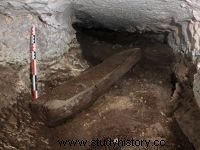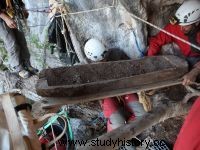In a cavity perched in the middle of a cliff in Haute-Corse, archaeologists are exploiting an exceptional discovery:two perfectly preserved 3000-year-old wooden coffins.

A crate carved directly from the trunk of a tree is one of the exceptional discoveries in this cavity.
CAVITY. It is a suitable place for eternal rest:a cavity seven meters long, barely two meters wide, with a low ceiling, located in the middle of a cliff in the territory of Lano, a municipality whose density is barely 3 inhabitants per km². From the bottom, you have to climb 25m; from the top, abseil 15m. Almost inaccessible. But this hole intrigues speleologist Jean-Claude La Milza and bat specialist Jean-Yves Courtois. Which ones, the 1 st March 2015, decide to try the visit. They thus fall on human bones and what looks like a chest. The alert is given to the Regional Archeology Service of the Regional Directorate of Cultural Action (DRAC) of Corsica. “Given the freshness of the bones, we were initially very skeptical about the interest of the discovery , admits Franck Léandri, director of the archeology department. But the radiocarbon dates are definitive:they date from the Bronze Age .
Four excavation campaigns later, embellished with the construction of a footbridge and the installation of a zip line, the cavity begins to reveal its contents. And he is exceptional. “Not so much for the presence of the bodies because we have already discovered in Corsica burials dating back more than 3000 years, but rather for the perfect degree of conservation of the boards and receptacles discovered “, specifies Franck Léandri. The site revealed the presence of six individuals, two children, a teenager and three adults whose sex has not yet been determined. The bones are not calcified and still include well-preserved biological tissues. Even rarer fact:cartilage was found.
IN IMAGES, IN PICTURES. In Corsica, mysterious 3000-year-old coffins
Let's find out how Bronze Age carpenters worked
ADZE. But it's the "coffins" that most excite archaeologists. There are two of them. One is made of planks cut from the heart of a yew that has retained its orange color despite the millennia that have passed. These elements are attached to each other by the mortise and tenon system and the lid of this chest was closed at both ends by pegs. “We can clearly see the traces of tools like the saw on the wood, which will give us valuable information on the way of working at that time, rejoices Franck Léandri. One of the sides thus shows that the craftsman has shown a certain mastery because the surface is relatively flat despite the presence of several large knots in the wood ". Archaeologists were able to reconstruct how the coffin was made.
Same interest for the “monoxyle” found further back in the cavity. A “monoxyle” is a crate carved directly from the trunk of a tree and which therefore stands in one piece. Here too, the piece found makes it possible to specify the manufacturing methods. In particular, we find the impacts of what must have been a kind of adze. Above all, we discovered a large pin that was to close the lid, which unfortunately disappeared. These pieces are now examined in Grenoble, in particular for carbon 14 dating.
One more piece in the European genetic puzzle
HYGROMETRY. Such exceptional conservation is explained by the geological history of the site and its morphology. The burial rests on a layer of limestone gravel, while animal remains – including pellets from the regurgitation of birds of prey – have protected the remains from any chemical aggression, as the water circulating in the cavity is not aggressive for the bones. In addition, the crevice was created by flows from the top of the cliff. The site is therefore connected to the surface from where the air can circulate. Thanks to the temperature differences between the upper opening and the opening in the cliff, the humidity of the cavity has remained low and stable in winter and summer for centuries.
Exploitation of the discovery has only just begun. The "sepulchral cavity of Leninca", its official name, is first of all part of a regional and European context. Throughout the Mediterranean, there is only one similar site, in the Balearic Islands. But, the correlations are even stronger with Danish burial sites where the monoxyls are similar. “It is not very surprising because in the Bronze Age, men already circulated a lot and trade circuits existed , explains Franck Léandri. For example, Baltic amber has been found in Corsica ". The presence of human tissue will also make it possible to extract the DNA of the 6 individuals. It will thus be possible to reconstitute possible family ties, but above all to obtain a new genetic reference in the large settlement network of the European continent.



